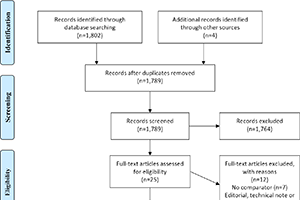Ravitch versus Nuss procedure for pectus excavatum: systematic review and meta-analysis
Abstract
Background: Pectus excavatum is the most common congenital chest wall deformity. The two most common surgical techniques for its correction are the modified Ravitch technique and the minimally invasive Nuss technique. Despite both procedures being used widely, data comparing them are scarce.
Methods: We conducted a systematic review and meta-analysis of comparative studies to evaluate these procedures. A systematic search of the literature was performed from six electronic databases. Pooled meta-analysis was conducted using odds ratio (OR) and weighted mean difference (WMD).
Results: A total of 13 studies comprising 1,432 pediatric (79.3%) and adult (20.7%) patients were identified, including 912 patients undergoing the Nuss procedure compared to 520 patients undergoing the Ravitch procedure. There was no significant difference found between the Nuss group versus Ravitch group in pediatric patients with regard to overall complications (OR =1.16; 95% CI: 0.61–2.19; I2=56%; P=0.65), reoperations (6.1% vs. 6.4%; OR =1.00; 95% CI: 0.40–2.50; I2=0%; P=1.00), wound infections (OR =0.58; 95% CI: 0.23–1.46; I2=0%; P=0.25), hemothorax (1.6% vs. 1.3%; OR =0.74; 95% CI: 0.21–2.65; I2=12%; P=0.64), pneumothorax (3.4% vs. 1.5%; OR =1.11; 95% CI: 0.42–2.93; I2=0%; P=0.83) or pneumonia (OR =0.15; 95% CI: 0.02–1.48; I2=0%; P=0.10). Adult patients undergoing the Nuss procedure had a higher incidence of overall complications (OR =3.26; 95% CI: 1.01–10.46; I2=0%; P=0.05), though there were far fewer studies that reported data.
Conclusions: These results suggest no difference between the Nuss and Ravitch procedures for pediatric patients, while in adults the Ravitch procedure resulted in fewer complications.
Cover






